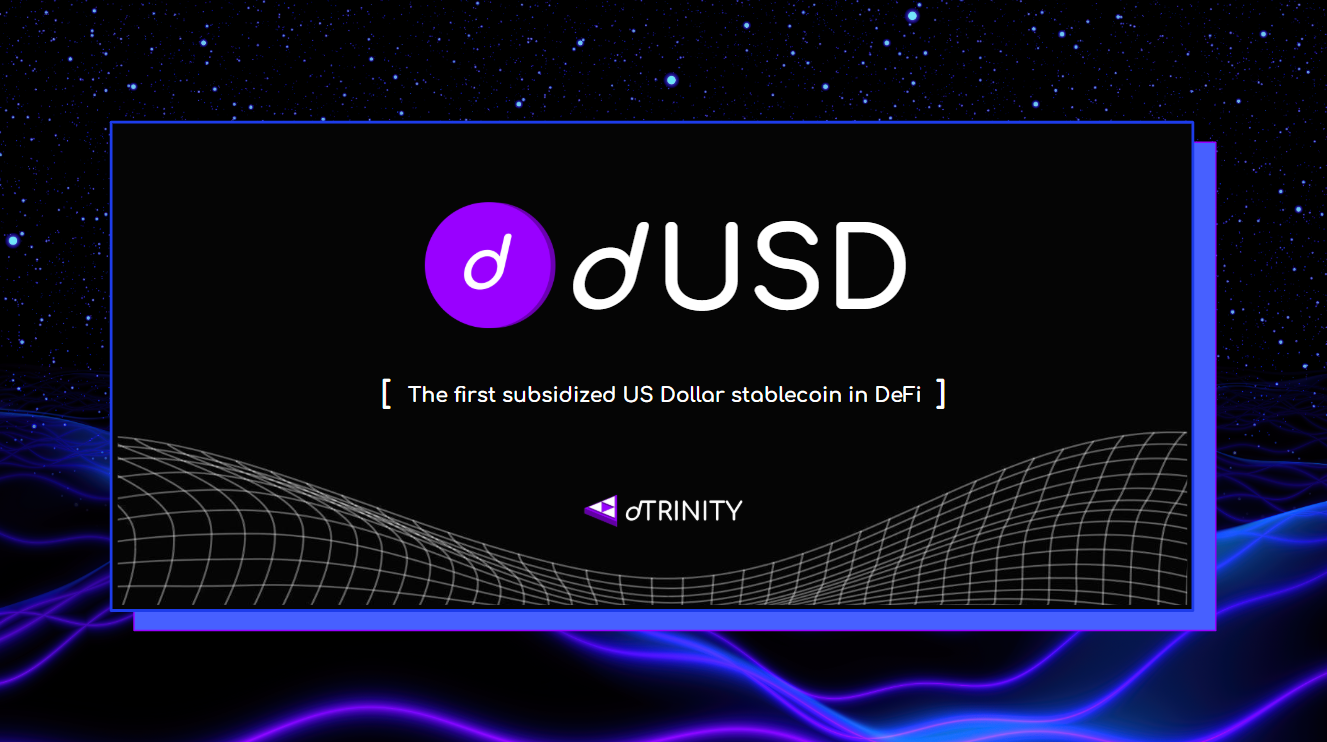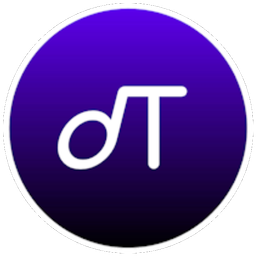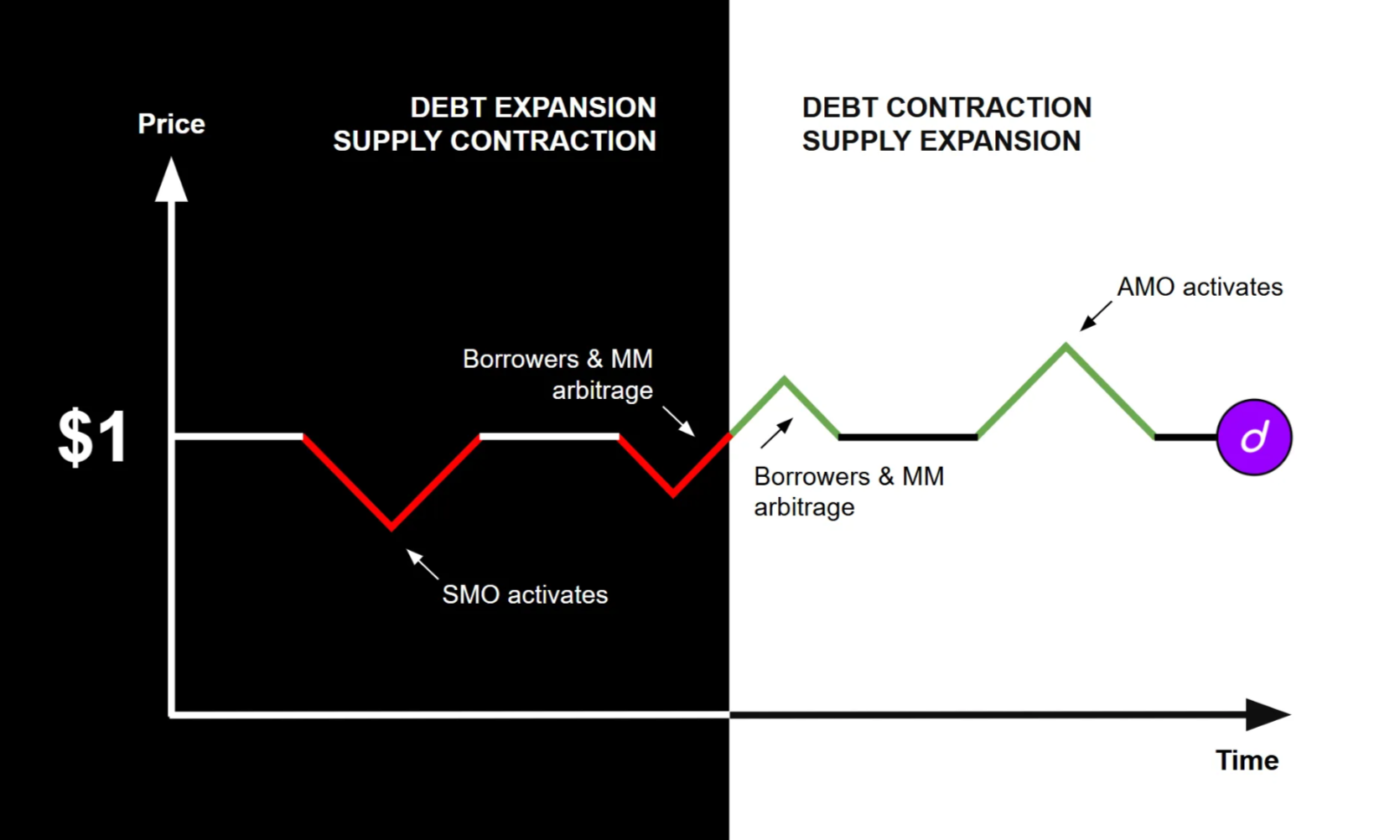
Overview
dTRINITY USD (dUSD) is a decentralized stablecoin, fully backed by a non-custodial reserve of USD-denominated stablecoins and yieldcoins. Built on the ERC-20 standard, each dUSD token is soft-pegged to $1—backed by at least $1 worth of collateral. dUSD can be minted and redeemed permissionlessly via smart contracts.
dUSD is deployed natively on Fraxtal L2, Sonic, Ronin, Katana with expansion to Ethereum and other networks coming soon.
For user instructions, please refer to our User Guide.
User Benefits
Unlike traditional stablecoin models that reward passive holders or stakers on the supply side, dUSD redirects reserve earnings as interest rebates to its borrowers on the demand side—effectively subsidizing their borrowing costs. This novel mechanism creates a higher supply-demand equilibrium vs. unsubsidized stablecoins like USDC and USDT, unlocking greater yields and capital efficiency for dUSD users.
dUSD lenders and LPs are also rewarded with  TRIN tokens on top of enhanced lending yields and pool fees (initially through the
TRIN tokens on top of enhanced lending yields and pool fees (initially through the  Points Program), giving them a stake in the protocol based on liquidity contribution. They may earn additional points and incentives from ecosystem partners as well, such as network rewards and protocol emissions. This community-centric approach is designed to benefit market participants on both sides of supply and demand, ensuring dTRINITY's success translates directly into enhanced value for its ecosystem members.
Points Program), giving them a stake in the protocol based on liquidity contribution. They may earn additional points and incentives from ecosystem partners as well, such as network rewards and protocol emissions. This community-centric approach is designed to benefit market participants on both sides of supply and demand, ensuring dTRINITY's success translates directly into enhanced value for its ecosystem members.
 TRIN tokens on top of enhanced lending yields and pool fees (initially through the
TRIN tokens on top of enhanced lending yields and pool fees (initially through the  Points Program), giving them a stake in the protocol based on liquidity contribution. They may earn additional points and incentives from ecosystem partners as well, such as network rewards and protocol emissions. This community-centric approach is designed to benefit market participants on both sides of supply and demand, ensuring dTRINITY's success translates directly into enhanced value for its ecosystem members.
Points Program), giving them a stake in the protocol based on liquidity contribution. They may earn additional points and incentives from ecosystem partners as well, such as network rewards and protocol emissions. This community-centric approach is designed to benefit market participants on both sides of supply and demand, ensuring dTRINITY's success translates directly into enhanced value for its ecosystem members.For more information, please refer to Yields & Rewards.
Collateral Reserves
Through its stablecoin and yieldcoin reserves, dUSD is able to maintain collateral transparently without directly relying on the traditional banking system. The protocol selects each reserve asset strategically based on its quality, track record, yield, and risk profile. As dTRINITY evolves, governance shall evaluate opportunities to diversify the reserve with new assets or remove those that no longer meet the protocol's standards.
To isolate chain-specific risks and mitigate cross-chain contagion, dUSD reserves are segregated by network. This means each dUSD deployment maintains its own independent reserve to back the circulating supply on that network. As a result, dUSD tokens are designed to be non-fungible across chains (e.g., Fraxtal dUSD ≠ Sonic dUSD). To move funds between integrated networks, cross-chain swaps for non-fungible dUSD variants will be facilitated via CrossCurve.
Below are the addresses for dUSD and its segregated reserves on each supported network:
Network | dUSD Token Address | Reserve Address |
Fraxtal L2 | ||
Sonic | ||
Ronin | ||
Katana |
The following reserve assets are currently whitelisted for minting/redeeming dUSD:
Reserve Asset | Type | Network | Mint & Redeem Ratio |
☑️ frxUSD | Stablecoin | ☑️ Fraxtal, Sonic, Katana
⏳ Ethereum | $1 of frxUSD = 1 dUSD |
☑️ sfrxUSD | Yieldcoin | ☑️ Fraxtal, Sonic, Katana
⏳ Ethereum | $1 of sfrxUSD = 1 dUSD |
☑️ DAI | Stablecoin | ☑️ Fraxtal | $1 of DAI = 1 dUSD |
☑️ sDAI | Yieldcoin | ☑️ Fraxtal | $1 of sDAI = 1 dUSD |
☑️ USDC | Stablecoin | ☑️ Fraxtal, Sonic, Ronin, Katana
⏳ Ethereum | $1 of USDC = 1 dUSD |
☑️ USDT | Stablecoin | ☑️ Fraxtal, Katana
⏳ Ethereum | $1 of USDT = 1 dUSD |
☑️ AUSD | Stablecoin | ☑️ Katana | $1 of AUSD = 1 dUSD |
☑️ yUSD | Yieldcoin | ☑️ Katana | $1 of yUSD = 1 dUSD |
☑️ scUSD | Stablecoin | ☑️ Sonic | $1 of scUSD = 1 dUSD |
☑️ wstkscUSD | Yieldcoin | ☑️ Sonic | $1 of wstkscUSD = 1 dUSD |
⏳ USDS | Stablecoin | ⏳ Ethereum | $1 of USDS = 1 dUSD |
⏳ sUSDS | Yieldcoin | ⏳ Ethereum | $1 of sUSDS = 1 dUSD |
⏳ Others (TBD) | Stablecoin or Yieldcoin | TBD | $1 of ____ = 1 dUSD |
Reserve assets may also include LP positions in the following designated liquidity pools (via algorithmic market operations):
Reserve Asset | Type | DEX | Network |
Stablecoin/Stablecoin | Curve | ☑️ Fraxtal, ⏳ Ethereum | |
Stablecoin/Yieldcoin | Curve | ☑️ Fraxtal, ⏳ Ethereum | |
⏳ Others (TBD) | Stablecoin/Stablecoin
Stablecoin/Yieldcoin | TBD | TBD |
Price Oracles
The dUSD reserve's NAV (net asset value) and minting/redemption ratio per reserve asset are determined based on each asset's USD price feed via oracles like Api3, RedStone, and Chainlink. More oracles will be incorporated in the future to enhance the reliability of price feeds.
To protect against de-pegging events caused by temporary market liquidity issues, oracle price feeds for yieldcoins are based on the unit NAV of their underlying holdings rather than market-traded prices. For example, Api3 provides a feed for sfrxUSD/frxUSD (how much frxUSD is staked per sfrxUSD) and frxUSD/USD (how much frxUSD is trading for). The final price of sfrxUSD is then determined by multiplying sfrxUSD/frxUSD with frxUSD/USD.
If a stablecoin feed like frxUSD/USD trades at a premium above $1, the dUSD minting contract will round it down to exactly $1. This prevents minting activities from posing under-collateralization risk. Conversely, if a reserve asset devalues significantly and does not recover within a 24-hour period, governance can assess the situation and take action to de-risk the reserve by swapping the devalued asset out for an uncorrelated asset. Additionally, governance can temporarily or permanently suspend minting with the devalued asset. These measures help the protocol manage risks and mitigate impacts from sudden market shocks.
Note: The price of dUSD is hard-coded to $1 on lending protocols. Additionally, dUSD is disabled as a borrowing collateral by default to prevent subsidy arbitrage from users who may loop dUSD against itself.
Stability Mechanisms

1. Stability Market Operations (SMO)
SMOs are akin to the Fed’s open market purchases of financial assets. However, unlike the Fed's approach of expanding the money supply through debt issuance (i.e., printing USD to buy bonds), SMOs are designed to maintain dUSD's price stability during credit expansion cycles by contracting its reserve and circulating supply.
When dUSD trades below $1, the protocol may use its full-reserve backing to strategically buy back and redeem dUSD from DEX pools. This stabilizes the peg and strengthens the reserve through arbitrage profits from buying dUSD at a discount.
SMOs typically take place during periods of high selling pressure—for example, when borrowers swap dUSD for other assets to loop or increase leverage.
2. Algorithmic Market Operations (AMO)
AMOs are akin to the Fed’s open market sales of financial assets. However, unlike the Fed’s approach of contracting the money supply through debt reduction (i.e., selling balance sheet assets for USD), AMOs are designed to maintain dUSD's price stability during credit contraction cycles by expanding its reserves and circulating supply.
Pioneered by Frax, the AMO mechanism can automatically execute monetary policies on-chain to enhance a stablecoin’s liquidity and price stability. Similarly, dUSD's AMOs complement its SMOs by expanding the money supply with pre-minted tokens. These unallocated tokens sit on both sides of the reserve’s balance sheet. When dUSD trades above $1, the protocol may allocate or sell these tokens to designated dUSD pools, obtaining new reserves in the process. This also stabilizes the peg and strengthens dUSD’s reserve through arbitrage profits from selling tokens at a premium.
AMOs enable faster protocol response to increased dUSD buying pressure on DEXs, such as when borrowers unloop or deleverage.
3. Borrower Arbitrage
When dUSD trades below $1, existing borrowers have a natural incentive to buy it back at a discount and repay their dUSD-denominated debt at face value. Conversely, when dUSD trades above $1, borrowers can supply collateral in dLEND or partnered lending protocols, borrow dUSD at $1, and sell it at a premium to capture arbitrage profits. These processes also help reinforce dUSD's soft peg to $1.
4. Market Maker Arbitrage
Like borrowers, market makers are naturally incentivized to buy dUSD when it trades at a discount to front-run SMOs/borrowers and capture arbitrage profits for themselves. Conversely, they can mint new dUSD tokens at par to sell when it's trading at a premium. As market makers add more liquidity, dUSD’s soft peg to $1 would gradually improve, decreasing its reliance on SMOs and AMOs to maintain stability.
5. Growing Collateral Ratio
Over time, a portion of protocol revenue—from SMO/AMO profits and reserve earnings—accumulates as excess reserves, pushing dUSD above a 100% Collateral Ratio. This helps strengthen market confidence and price stability while creating a buffer against potential reserve devaluation. When the Collateral Ratio exceeds a certain threshold, protocol governance can determine how to allocate the excess reserves, such as funding extra subsidies or acquiring BTC and ETH as strategic reserve assets.
Dynamic Interest Rebates
dTRINITY has a mandate to allocate at least 90% of dUSD's reserve holdings in yieldcoins to generate subsidy funding. These holdings shall be optimized to target DeFi yield benchmarks (e.g., Sky sUSDS, Aave aUSDC), ensuring the protocol generates sufficient reserve earnings to incentivize users competitively.
The protocol mints new dUSD periodically using a majority of reserve earnings during that period in order to subsidize dUSD interest expenses on lending protocols. These freshly minted tokens are distributed to dUSD borrowers as interest rebates. The remainder of reserve earnings is retained either as protocol revenue or excess reserves to over-collateralize dUSD.
The “Rebate APY” displayed in dUSD lending markets shows the current net rebate rate that borrowers can earn based on their active dUSD debt. This rate is variable and depends on the reserve’s intrinsic yield as well as the ratio between dUSD's circulating supply vs. its TDL (Total Debt Locked).
Recursive Lending (Re-Lending)
When borrowers exchange dUSD for other assets, it flows into liquidity pools where other users may acquire and re-lend it. Users may also borrow dUSD and re-lend it to take advantage of carry trade opportunities when dUSD’s Supply APY is higher than its net Borrow APY (post-rebates). As dUSD gets re-lent multiple times, it creates a money supply and debt multiplier effect similar to the traditional banking system. This means the aggregate value of dUSD deposits and debt on lending protocols may exceed its total circulating supply (i.e., the base money supply).
Rebate APY vs. Debt Ratio
When dUSD’s TDL is the same as its total circulating supply, the net Rebate APY is the same as the reserve’s intrinsic yield. When TDL exceeds the circulating supply due to re-lending, the net Rebate APY becomes diluted and decreases below the intrinsic yield because there are fewer yield-bearing reserves and more debt to subsidize. On the contrary, when TDL is less than the circulating supply, the Rebate APY becomes concentrated and increases above the intrinsic yield because there are more reserves and less debt to subsidize. Therefore, the Debt Ratio as well as the net Rebate APY will fluctuate over time and can be calculated as follows:
- Debt Ratio = Total Debt Locked / Circulating Supply
- Net Rebate APY = (Reserve Intrinsic Yield * 90%) / Debt Ratio
Below is an example of rebate calculations, assuming that the reserve’s intrinsic yield is 5% APY:
Total Debt Locked | Circulating Supply | Debt Ratio | Rebate APY |
10,000 dUSD | 100,000 dUSD | 0.10 | 45.00% |
25,000 dUSD | 100,000 dUSD | 0.25 | 18.00% |
50,000 dUSD | 100,000 dUSD | 0.50 | 9.00% |
100,000 dUSD | 100,000 dUSD | 1.00 | 4.50% |
200,000 dUSD | 100,000 dUSD | 2.00 | 2.25% |
500,000 dUSD | 100,000 dUSD | 5.00 | 0.90% |
1,000,000 dUSD | 100,000 dUSD | 10.00 | 0.45% |
Since there are yield-bearing reserves constantly backing dUSD, even as the Debt Ratio increases, the net Rebate APY always remains above zero. Therefore, interest rebates help lower the effective equilibrium of dUSD borrowing costs vs. unsubsidized stablecoins. When the Debt Ratio and utilization are high, interest rebates may be marginal, but when they are low, rebates may become quite substantial—potentially producing negative borrowing rates (i.e., getting paid to borrow, net of rebates). This makes dUSD a super cost-effective debt instrument, ensuring constant credit demand and utilization on integrated lending protocols.
Note: dTRINITY may boost the Rebate APY with its available marketing budget during promotional periods.
